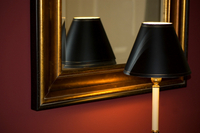Lounge Shopper
- Home
- Add Listing
- Accessory Shops
- Art
- Auto
- Computing
- Directories
- Electronics and Cameras
- Fashions
- Finance and Property
- Food and Drink
- Gifts and Flowers
- Health and Beauty
- Home and Garden
- IT
- Music
- Pets
- Price Comparison Websites
- Sports and Hobbies
- Toys Babies and Kids
- Travel
- Blog
Quick Search
 LED Lighting and it’s myriad application varies in many ways. From LED strip lighting applications for care establishments to LED rope lighting for the purpose of display, to the much vaunted IoT application in Li-Fi in the foreseeable future, the future is indeed LED. Yet the applications of the product aren’t just commercial. Lighting usually accounts for up to 40% of the average homeowner's electricity bill, and energy hikes in recent years have proved to be intolerable and unmanageable for many home owners. Within the winter months it’s increasingly more common to see people of all age brackets actively cutting down their energy usage and tightening their belts in order to not create bills they simply cannot afford to pay. While we cannot do anything about what prices energy corporations set for their product, as consumers we have the power to do something about our own energy wastage. LED lighting has been an option in residential settings for quite some time, but prohibitive startup costs have dissuaded a lot of home owners. It's difficult to spend money in order to save money when you simply don’t have money -- yet this is not to be the way for long. Recent knockdowns to the cost of manufacturing LED products mean that the costs of purchasing LED units has come down in a big way for the consumer, with now being an ideal time to make the change to LED for the sake of saving money by waste elimination when winter hits and energy prices are undoubtedly hiked upward. It’s summer, in 2016. But it’s best to start early, there’s so much money to be saved. The benefits of switching to LED Lighting are: - Cost-effectiveness. LEDs require far less power (Watt) to produce each unit of light generated. (Lumen) For example, regular lightbulbs require 40 Watts of electricity to produce 450 Lumens. Compact Fluorescent Lightbulbs do much better – yet still require 9-13 watts to produce the same amount of light. LED lighting renders both products entirely obsolete -- requiring only 4-5 watts to produce the same 450 Lumens. LEDs are incredibly efficient, with far less waste being produced. - Less Carbon Emissions. Carbon dioxide is a by-product of the way that traditional halogen lightbulbs operate. They emit the substance as a waste product of the heat they create, and you’re actually paying your electricity bill to produce light… and C02. Replacing a halogen lamp with an LED option enables you to reduce 250kg of C02 emissions a year. That’s gigantic. - No mercury. Regular halogen lightbulbs are actually guilt-free for this point, though their replacement, the Compact Fluorescent Bulb (most know them as energy efficient lightbulbs) have a rather large flaw in the fact that they contain the chemical Mercury which of course is highly toxic for humans, animals… and generally awful for the environment – a large slap in the face for the future we hope to leave our children. - Increased lifespan. LEDs can last up to 25 times as long as a regular halogen bulb, boasting lifespans of up to 50,000 hours. If you switched to LED, and even left your lighting on constantly for 24 hours a day, you'd still see them working 6 years later. The savings from not having to replace your lighting every few months are certainly not to be dismissed. It's simple. The sooner you change to LED lights, the sooner you'll save on your electricity bill. While it seems that as consumers, we have the ability, finally, to make changes to our current products to combat wastage and money going directly down the drain.
|
Archives
February 2023
January 2023
October 2022
May 2022
February 2022
October 2021
March 2021
February 2021
December 2020
September 2020
August 2020
June 2019
May 2019
March 2018
August 2017
May 2017
April 2017
March 2017
February 2017
January 2017
December 2016
November 2016
October 2016
September 2016
August 2016
May 2016
March 2016
February 2016
January 2016
November 2015
October 2015
September 2015
August 2015
July 2015
June 2015
May 2015
October 2014
August 2014
May 2014
March 2014
February 2014
November 2013
August 2013
November 2012
October 2012




